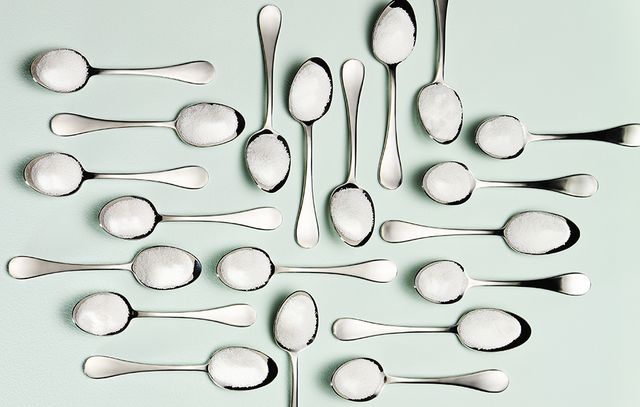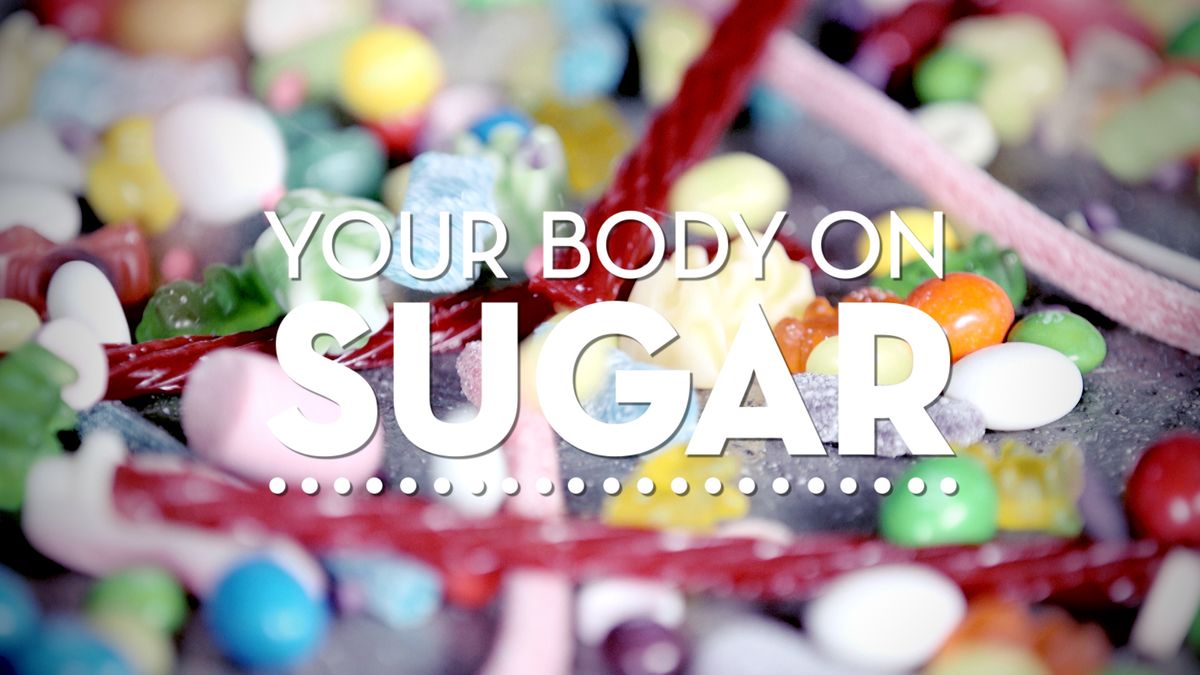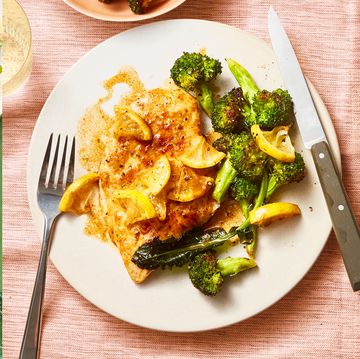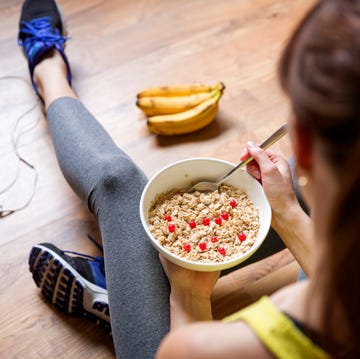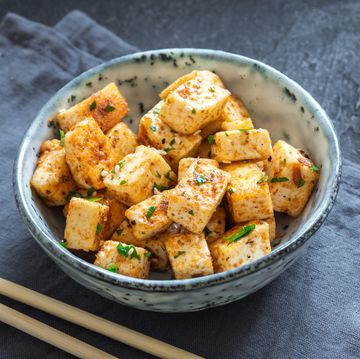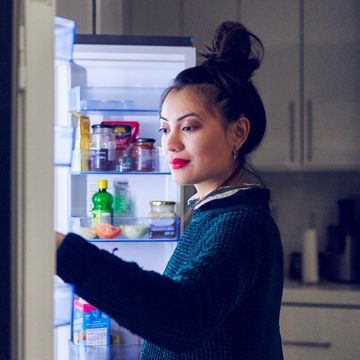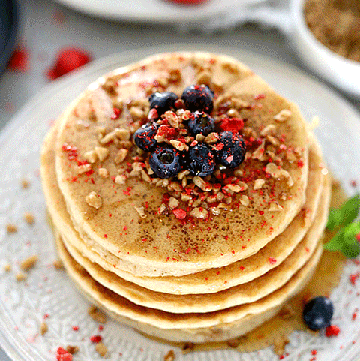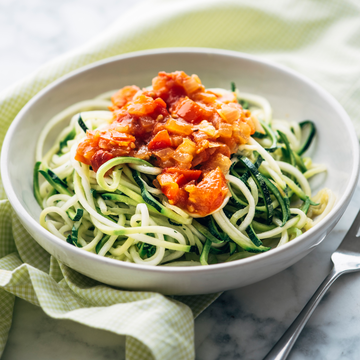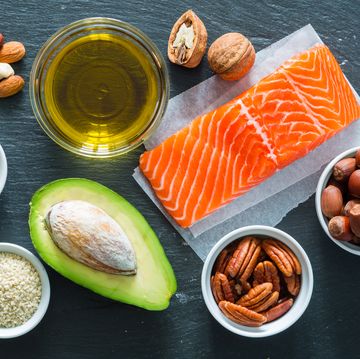If you've resolved to eat healthier this year, cutting the amount of added sugar in your diet is one of the best first steps you can take. The average American consumes 22 tsp (88 g) of added sugar per day—a staggering amount, considering the American Heart Association recommends that women limit their intake to 6 tsp (24 g) per day and men to 9 tsp (36 g).
MORE: Chicken Can Help You Ditch Cravings, Fill Up, and Slim Down. Here's a 28-Day Plan that Works.
The good news: Training yourself to prefer less-sugary foods doesn't require a restrictive diet. By becoming aware of how sugar works in the body, learning where hidden sugar lurks, and recalibrating your taste buds, you can increase your energy and lower your disease risk. The best part: It will take only 7 days.
Watch this video to see just how much sugar affects your body:
How sugar affects the body and brain
Experts have long known that high sugar intake can lead to obesity, a risk factor for many health conditions, but newer research suggests that added sugar may also increase your disease risk in other ways when consumed in excess.
"Your blood sugar rises rapidly, which creates inflammation over time," says David Ludwig, a professor at the Harvard T.H. Chan School of Public Health and physician at Boston Children's Hospital. If the inflammation becomes chronic, it can trigger a cascade of changes in the body (such as narrowing of the arteries and insulin resistance) that may eventually lead to chronic disease.
MORE: 3 Women On How To Have A Kick-Ass Life In Spite Of Chronic Illness
Naturally occurring sugars—those found in small amounts in fruits, vegetables, and milk—are not the culprits in this process. These foods contain important nutrients and are often high in fiber, which slows the absorption of sugar into the bloodstream. The kind that causes health problems is added sugar—any type, from agave to sucrose, that's added to food during preparation or processing. (See the list at right for other common names for added sugar.)
Research suggests that added sugar is a major contributor to the development of conditions that were long blamed on other dietary factors. A 2014 BMJ Open Heart study revealed that added sugar may increase the risk of hypertension even more than sodium does. Research published a year later in Progress in Cardiovascular Diseases suggested that sugar plays a greater role in heart disease than saturated fat does. And leading an otherwise healthy lifestyle doesn't appear to offset the effect: A JAMA Internal Medicine study revealed that the more added sugar people ate, the greater their risk of dying of heart disease—regardless of their physical activity level and weight.
Scientists are also learning that sugary, highly processed foods may have a profound effect on the brain. "There's a compelling argument being made that Alzheimer's disease is actually 'type 3 diabetes,' or insulin resistance of the brain," says David Katz, founding director of the Yale-Griffin Prevention Research Center and a Prevention advisory board member. While experts have known for years that people who have diabetes are at greater risk of brain shrinkage and dementia, new studies are showing that even those whose blood sugar levels fall short of a diabetes diagnosis may be vulnerable to these changes. A 2012 Australian study showed that people with blood sugar levels at the high end of the normal range were more likely to have a loss of brain volume in the hippocampus and amygdala—areas involved in memory and cognition—than were people who had lower blood sugar levels.
Exactly how sugar harms the brain is unclear, though inflammation likely plays a role. "It may also be that a diet high in sugar crowds out nutrients that are essential for brain health," Katz says. "This may disrupt neurotransmitter levels, which impairs the brain's ability to communicate with itself and could also contribute to mood disorders such as depression."
MORE: The Beginner’s Guide To Ditching Processed Foods
Where added sugar lurks
Added sugar tends to hang out in these unsuspecting foods:
- Multigrain bread (1 slice): 1 tsp
- Raisin bran (1 cup): 1 ¾ tsp
- Tomato soup (1 cup): 2 tsp
- Marinara sauce (1/2 cup): 2 ¼ tsp
- Fruit-flavored yogurt (5 oz): 3 tsp
- Instant apple cinnamon oatmeal (1 packet): 2 ½ tsp
- Vanilla almond milk (1 cup): 3 ¾ tsp
- Sports drink (8 oz): 3 ½ tsp
MORE: 15 Low-Sugar Snacks To Help You Lose Weight
Why it's so hard to quit (but doesn't have to be)
It's easy to follow what seems like a healthy diet and still eat too much added sugar. "People don't realize just how much is hidden in the food they eat, even salad dressing and tomato sauce," Katz says.
Complicating matters is the fact that food labels list the number of total grams of sugar, which also includes naturally occurring sugars. While manufacturers will eventually be required to list added sugar separately, the change isn't planned to take effect until July 2018 (small businesses will have an additional year to comply).
MORE: Top 4 Things Nutritionists Look For On A Food Label
The sugar cycle
How it tricks the brain into wanting more:
- Excess sugar drives the pancreas to produce extra insulin, a hormone involved in blood sugar regulation.
- The insulin signals fat cells to store excessive amounts of glucose, fatty acids, and other substances rich in calories.
- With too few calories remaining in the bloodstream, the brain, which has very high energy needs, believes it's now low on fuel.
- As a result, your hunger level rises quickly. Sugar is alluring when you're hungry because it provides quick energy.
There's also a confusing health halo over less-processed sugar products, like honey. "While honey does have some beneficial micronutrients, using it in place of table sugar won't lower cravings for sweet foods," says Dawn Jackson Blatner, a registered dietitian in Chicago.
But the most influential factor is sugar's effect on biology. "There's a misconception that we eat sugary foods because they taste good," Ludwig says. "However, we also eat them because they produce changes in the body that make us crave them." (See the box at left for more on how this happens.)
The intensity of these cravings has led some to claim that sugar is addictive. Studies have shown that sugary foods activate a region of the brain called the nucleus accumbens—the center for reward, craving, and addiction. But Katz stops short of saying sugar is truly addictive. "There's some overlap between addiction and our body's reaction to sugar," he says. "But substances like drugs and alcohol hijack our brain's reward system in a far more extreme way."
Cutting back on sweet foods can actually make resisting sugar easier. "The first thing people notice when they limit added sugar is that their cravings are reduced," Ludwig says.
MORE: What Your Food Cravings Are Trying Desperately To Tell You
Smart food swaps
SWAP FLAVORED YOGURT FOR FULL-FAT PLAIN YOGURT.
Chicago-based registered dietitian Dawn Jackson Blatner recommends opting for yogurt with at least 2% fat, since fat makes the yogurt creamier and less tart. Add mashed fruit or toasted unsweetened coconut flakes for extra flavor.
SWAP SUGARY DRINKS FOR WATER OR TEA.
Experiment with creative ways of flavoring water. "Try making mojito water with mint and lime," Blatner suggests. Or add a splash of 100% fruit juice to seltzer. Keep unsweetened dessert teas (such as cinnamon) on hand for after dinner.
SWAP SALAD DRESSING FOR BALSAMIC VINEGAR.
Added sugar sneaks into many dressings, especially reduced-fat or French varieties. Replace them with a mixture of balsamic vinegar, feta, and avocado, or mix fruit juice into a low-sugar vinaigrette dressing.
30% INCREASE IN ADDED SUGAR CONSUMPTION BY AMERICAN ADULTS BETWEEN 1977 AND 2010
Quick fixes for sugar cravings:
- Whole wheat toast (check for no added sugar) + Cream cheese + Berries
- Freeze-dried banana chips + Cacao nibs
- Almonds + Dried goji berries + Toasted coconut flakes
- Sweet bell pepper slices + Guacamole
- Cherry tomatoes + Mozzarella balls
How to detox from added sugar
In as little as 1 week, you can begin to train your taste buds to stop craving foods loaded with added sugar—while still eating carbohydrates, protein, and healthy fats to stay satisfied. The key is to prepare food at home when you can; double-check the labels of foods you buy; and use fruits, vegetables, herbs, and spices, rather than sweeteners, for flavor. "When your diet is bland and boring, you're more likely to seek out sugar," says Wendy Bazilian, a registered dietitian and a Prevention advisory board member. Here's what to do.
STEP 1: GET IN THE RIGHT MIND-SET.
It's important to avoid labeling yourself. Saying things like "I'm powerless around sugar" or calling yourself a sugar addict can hurt your chances of success. "These phrases can be a self-fulfilling prophecy," Blatner says. It's also best to avoid the word can't during this detox: Instead of telling yourself I can't have that when you're faced with temptation, think I don't eat that. The former feels like you're punishing yourself, while the latter is empowering. (Try this 1-minute meditation to kick food cravings.)
STEP 2: CUT SUGAR FOR 1 WEEK.
Turn the page for our sugar detox meal plan created by Bazilian. It guides you through your first week as you eliminate added sugar to recalibrate your taste buds. Note that fruit is included in many of your meals and snacks.
Not only will this satisfy your desire for sweetness, but eating ample amounts of fruit will also make you less likely to experience the headaches and crankiness that often come with extreme sugar detoxes. When you crave dessert, make it fruit-based (like the homemade fruit sorbet on day 6 of the detox).
You might miss added sugar for the first few days, but as your energy and mood improve, you'll be glad you made a change. If you're still craving added sugar after a week, don't be too hard on yourself—simply repeat the meal plan for another week.
PERCENTAGE OF ADULTS WHO REGULARLY USE. . .
HONEY: 47%
TABLE SUGAR: 44%
RAW SUGAR: 25%
AGAVE: 9%
MOLASSES: 7%
STEP 3: SLOWLY REINTRODUCE SUGAR.
After detoxing, treat yourself to "social sweets" only—meaning sweets you eat with others in fun situations. This way, you keep added sugar out of your home without denying yourself the occasional sweet. "You can tell yourself, I don't need to eat sugary treats in the house because I'm going to have a better dessert when I go out with my friends tomorrow," Blatner says. At home, aim to flavor all your foods with only naturally occurring sugars.
MORE: 6 Things That Happened When I Stopped Eating Sugar
STEP 4: DON'T EXPECT PERFECTION.
Now that you know how powerful a sweet tooth can be, you won't be surprised to experience at least a few challenging moments as you detox from added sugar. But don't let that discourage you: "Tell yourself, This is just 1 week, and I'm going to feel amazing," Bazilian suggests. "Remind yourself that you've done much harder things in life."
If you do give in to a craving, don't blame yourself or give up. "Recognize how omnipresent sugar is and how easy it is to give in to temptation," Bazilian says. "Then get back on track and don't sweat it. You really can change your lifelong eating patterns."
Your 7-day detox meal plan
These flavorful meals and snacks replace added sugar with healthy produce, nuts, and spices.
DAY 1
- Breakfast: 1 toasted whole wheat English muffin (check for no added sugar) topped with natural peanut butter, apple slices, and a sprinkle of cinnamon
- Lunch: 1 cup Romaine lettuce tossed with chickpeas, grape tomatoes, sliced cucumber, chopped red onion, crumbled feta, olives, extra virgin olive oil, and balsamic vinegar
- Snack: Homemade trail mix made with 2 Tbsp walnuts and 2 Tbsp raisins
- Dinner: 1 cup whole grain pasta tossed with chunky tomato sauce (check for no added sugar) and mixed vegetables (such as broccoli, zucchini, and mushrooms)
DAY 2
- Breakfast: 1/2 cup cooked plain oatmeal made with milk, topped with slivered almonds and raisins
- Lunch: 1 cup broccoli tossed with white beans, quinoa, chopped red onion, balsamic vinegar, extra virgin olive oil, and red-pepper flakes (if desired)
- Snack: 3/4 cup Greek yogurt with raspberries or a sliced banana
- Dinner: Tomato soup served with 1 cup lettuce tossed with chopped bell pepper, lentils, raisins, and sliced cucumber
- Dessert: 3 dates, pitted and stuffed with walnuts
DAY 3
- Breakfast: Smoothie made with 1/2 cup fresh or canned pumpkin, 1/2 cup milk, 1/4 cup plain Greek yogurt, 1 medium orange, pumpkin pie spice, and a handful of ice
- Lunch: 6" whole grain wrap (check for no added sugar) filled with hummus, baby spinach, grated carrots, and sliced red bell pepper
- Snack: 3 dried apricots and 20 pistachios
- Dinner: 3 oz baked salmon topped with orange slices and thyme, served with fingerling potatoes and spinach tossed with sautéed broccoli and more orange slices
DAY 4
- Breakfast: 1 cup plain Greek yogurt topped with blueberries or raspberries and chopped walnuts
- Lunch: 1 whole grain pita (check for no added sugar) stuffed with feta, pecans, spinach, a drizzle of balsamic vinegar, and a sliced pear, served with blueberries or an apple
- Snack: 1 large rib celery filled with natural peanut butter
- Dinner: 4 oz cubed tofu or chicken breast sautéed in olive oil with chopped bell pepper, snap peas, sliced mushrooms, garlic, and white onion, served with cooked brown rice
DAY 5
- Breakfast: Omelet filled with chopped bell pepper and sliced mushrooms, served with blueberries and 1/2 slice whole wheat toast (check for no added sugar) with butter
- Lunch: Turkey Burger With Tomato Jam
- Snack: 1 medium orange and a handful of almonds
- Dinner: 2 small slices pizza made with thin whole wheat crust (check for no added sugar) and topped with pesto, a sprinkling of cheese, and extra veggies, served with leafy greens
DAY 6
- Breakfast: 1 toasted whole grain corn tortilla topped with mashed avocado, a squeeze of lemon juice, and a sprinkle of red-pepper flakes (optional: add a poached egg)
- Lunch: 1 cup minestrone soup (check for no added sugar) and a salad of arugula tossed with balsamic vinegar, extra virgin olive oil, pepitas, and orange segments
- Snack: 1/2 cup snap peas and 1/2 cup carrots, served with hummus
- Dinner: Chicken Stir-Fry
- Dessert: 1 frozen banana pureed with 1/2 cup frozen mango (return to freezer before serving)
DAY 7
- Breakfast: No-Syrup Pancakes
- Lunch: Sandwich with 2 slices whole wheat bread (check for no added sugar), natural peanut butter, and sliced strawberries, served with carrot sticks
- Snack: 3/4 cup steamed edamame
- Dinner: 1 cup baby spinach sautéed in olive oil with sliced cherry tomatoes, topped with 4 oz chicken breast and served with a small baked sweet potato
